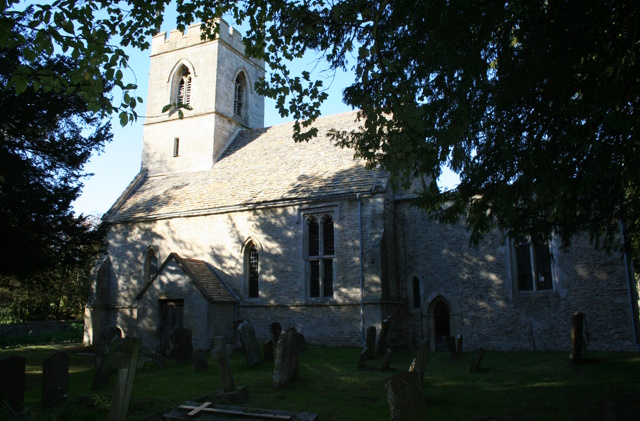


























The Church of the Holy Rood, Woodeaton
The Church of the Holy Rood in Woodeaton comprises nave, chancel, south porch, and tower. The main fabric of the nave and chancel were probably built in the third quarter of the 13th century. The chancel arch, the priest's door on the south wall of the chancel, and the lancet windows in the north and south walls of nave and chancel are of the same date. During the 15th century the two-storied tower was added; it was built inside the existing church, one of its walls being the original west wall of the church, and the other three sides resting on 15th-century arches protruding into the nave. It has been suggested that this plan was adopted because if the tower had been built outside in the usual way it would have touched the churchyard wall and prevented processions around the church. At about the same time two large square-headed windows were inserted in the south and east walls of the chancel, no doubt replacing earlier lancet ones. Probably early in the 18th century the gallery and south porch were added, the walls of the chancel were raised and the roof lowered, and the church was beautified with panelling. The chancel contains a 13th-century trefoiled piscina and stone sedilia. The plain cylindrical font is also contemporary with the church, and probably also the niche for baptismal oil east of the north door of the nave. The wall-painting on the north wall representing St. Christopher, uncovered and restored by Professor Tristram in 1930, dates from the 14th century. The rare French inscription reads, 'Ki cest image verra le jur de mal mort ne murra'. There are also traces of wall-painting over the south door.
The Elizabethan chalice and paten-cover are dated 1575. They may have been given by Richard Taverner when his son was presented to the living in that year. There is also an unusual round-bellied Elizabethan pewter flagon, a small silver paten of 1719, a large silver paten (hall-marked 1679), and a silver tankard flagon of 1702 presented by Martha Nourse. The treasures of the church at the Reformation included a silver cross, 3 vestments of velvet and satin, and 3 small bells. At that time there was a lamp in the church, supported by 6d. worth of lands. Provision for two altar cloths for the two altars in the body of the church had been left under Robert Bolt's will in 1530. Five of the six bells were given by John Nourse about 1680 and were described by Rawlinson as 'so sweet and tunable that they are called the Wood Eaton Flagalets'. The sanctus bell is dated 1674. The Nourses removed a monument to Richard Taverner, but left many of their own memorials. In the north wall is a tablet to Anne, first wife of John Nourse (d. 1669), and to her husband (d. 1708). Beneath is a tablet to his second wife Martha. In the chancel there are memorials to Richard Nourse (d. 1673), his wife Martha (d. 1673), their sons Richard (d. 1679) and Francis (d. 1687) with his wife Margaret (d. 1689); to Margaret Pitt (d. 1690), daughter of Dr. Robert Pitt and granddaughter of John Nourse; to four rectors, Thomas Jones (d. 1673/4) and his wife Anne, Richard Cobden (d. 1679), John Smith, D.D. (d. 1690), and Ralph Frank (d. 1731). Hatchments of the Weyland family hang in the church, but their vault is in the churchyard. The parish registers date from 1679, but they contain extracts from earlier ones seen by Wood, of which the baptisms date from about 1589, the marriages from before 1567, and the burials from about 1562. Historical information about The Church of the Holy Rood is provided by 'Parishes: Wood Eaton', in A History of the County of Oxford: Volume 5, Bullingdon Hundred, ed. Mary D Lobel (London, 1957), pp. 309-317. British History Online http://www.british-history.ac.uk/vch/oxon/vol5/pp309-317 [accessed 31 March 2023]. The Church of the Holy Rood is a Grade I listed building. For more information about the listing see CHURCH OF THE HOLY ROOD, Woodeaton - 1047562 | Historic England. For more information about the Church of the Holy Rood see Parishes: Wood Eaton | British History Online (british-history.ac.uk). |

